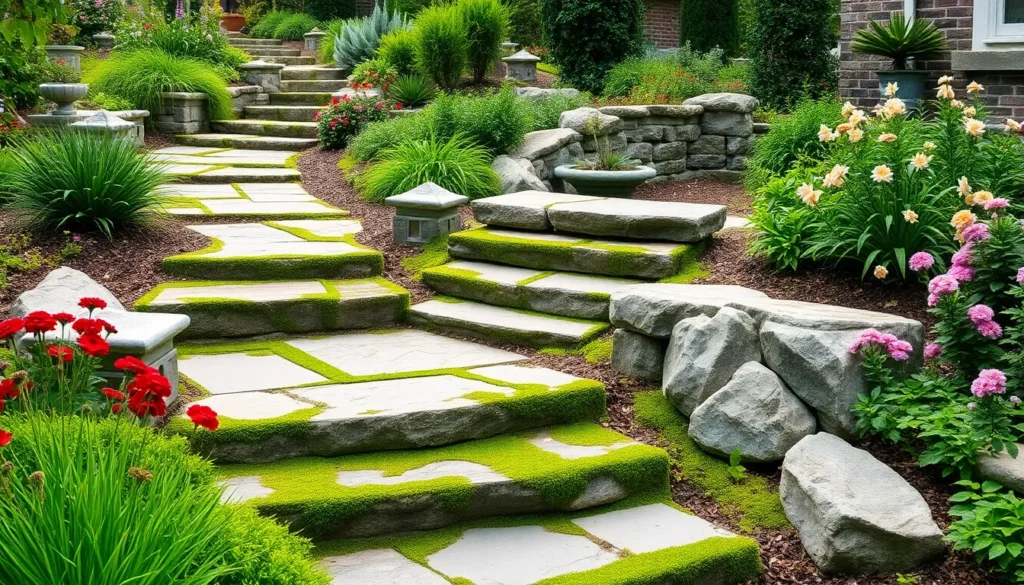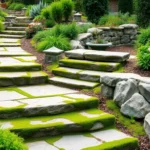Garden steps can transform a sloped yard from a challenging obstacle into a stunning focal point that adds both beauty and functionality to your outdoor space. Whether you’re dealing with a steep hillside or gentle grade changes, well-designed steps create safe pathways while improving your industry’s visual appeal.
We’ve discovered that the right step design doesn’t just solve practical problems – it creates opportunities for creative expression. From rustic stone terraces that blend seamlessly with natural surroundings to sleek concrete platforms that complement modern architecture, garden steps can become architectural features that define your outdoor style.
The best part? You don’t need a massive budget or professional contractor to create impressive results. With thoughtful planning and the right materials, we’ll show you how to build steps that not only guide visitors safely through your garden but also become conversation pieces that elevate your entire industry design.
Natural Stone Garden Steps for Timeless Elegance
Natural stone garden steps bring enduring beauty and lasting value to any outdoor space. These materials create sophisticated pathways that complement both traditional and contemporary garden designs while providing exceptional durability for years of use.
Flagstone Step Construction
Flagstone steps offer versatility in design with their naturally flat surfaces and varied color options. We recommend using flagstone pieces that are at least 2 inches thick to ensure stability and longevity. The irregular edges create organic appeal while maintaining a refined appearance that works beautifully with cottage gardens and formal landscapes alike.
Building flagstone steps requires careful attention to proper drainage and base preparation. We suggest creating a 4-6 inch gravel base beneath each stone to prevent shifting and cracking. Pennsylvania bluestone and Tennessee sandstone are popular choices that provide excellent slip resistance and weather durability in most climates.
Fieldstone Rustic Appeal
Fieldstone creates naturally weathered garden steps that blend seamlessly with countryside and woodland settings. These stones come in various sizes and shapes, allowing us to build steps with authentic character that appears to have been there for generations. The irregular surfaces and earth-tone colors complement native plantings and informal garden designs.
Selecting fieldstone for garden steps requires choosing pieces with relatively flat surfaces for safety and stability. We recommend using mortar joints between stones to prevent movement and create secure footing. Fieldstone steps work particularly well when paired with natural plantings like hostas, ferns, and wildflowers that soften the hardscape edges.
Granite Slab Durability
Granite slabs provide the ultimate in strength and longevity for high-traffic garden steps. We can expect granite steps to maintain their appearance and structural integrity for decades with minimal maintenance. The dense composition resists weather damage, staining, and wear from foot traffic better than most other natural stone options.
Installing granite slab steps requires professional cutting and placement due to their weight and hardness. We suggest choosing slab thicknesses of 2-3 inches for residential applications and 4-6 inches for commercial or heavy-use areas. Granite steps complement modern architectural styles and create striking focal points in contemporary garden designs with their clean lines and polished surfaces.
Wooden Garden Steps for Warmth and Character
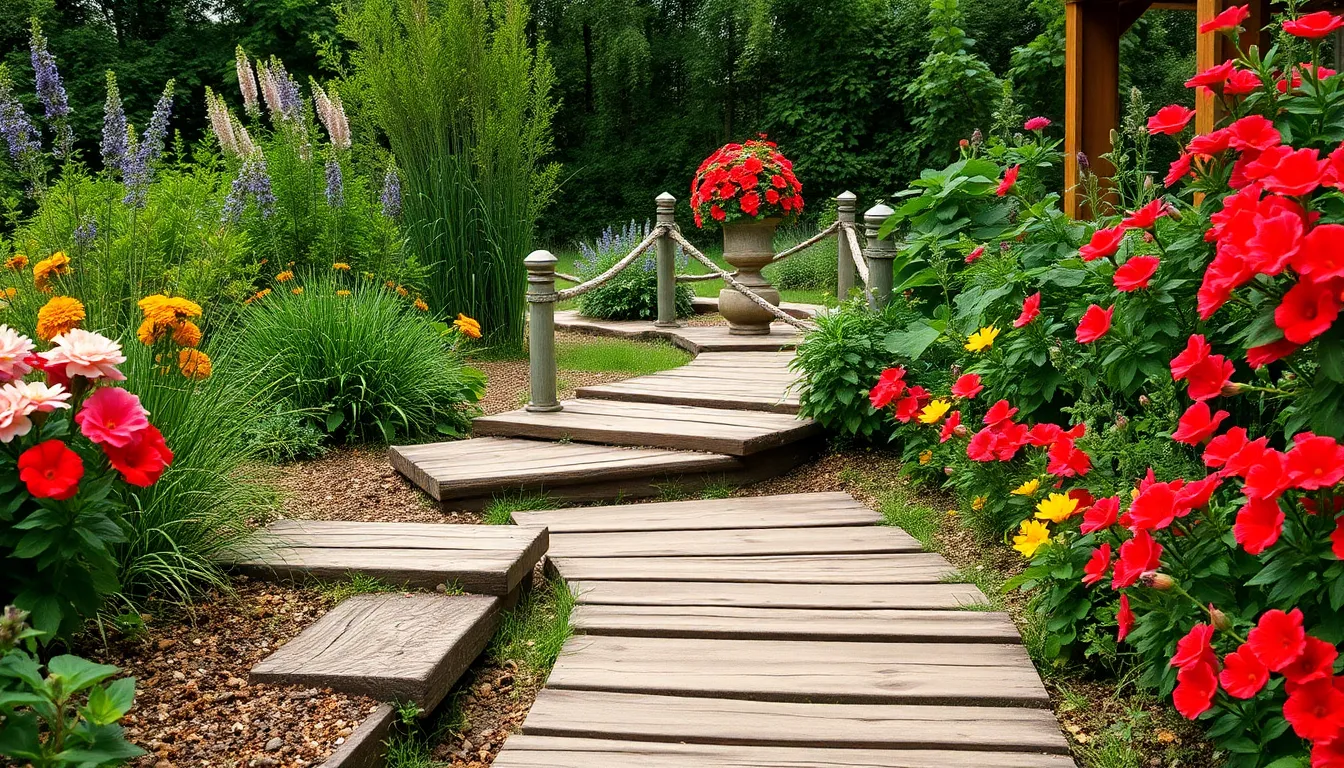
Wooden garden steps bring natural warmth and timeless character to outdoor spaces, creating inviting pathways that complement various garden styles from rustic to modern. They blend seamlessly with surrounding greenery, pebbles, and rocks while developing beautiful patinas over time.
Cedar Plank Steps
Cedar planks offer exceptional durability and natural weather resistance, making them ideal for outdoor garden step construction. This premium wood can be stained to match your garden’s aesthetic or left untreated to develop its characteristic silver gray patina naturally over time. Installation proves straightforward since cedar planks can be customized to fit different garden dimensions and slope requirements. Weather resistance comes naturally with cedar, as it contains oils that repel insects and moisture without requiring chemical treatments.
Railroad Tie Construction
Railroad ties provide a sustainable solution by repurposing reclaimed wood into functional garden steps with distinct rustic charm. These substantial timbers create sturdy, long lasting steps that can support heavy foot traffic while adding industrial character to your industry design. Staining or painting railroad ties allows customization to match your surrounding industry colors and overall garden theme. Environmental benefits make this option appealing since you’re giving new life to materials that might otherwise end up in landfills.
Log Step Integration
Log steps create the most organic appearance by using natural wood forms that blend seamlessly into garden environments. This approach enhances your garden’s natural beauty while providing a unique, handcrafted look that can’t be replicated with manufactured materials. Integration with existing industry features becomes effortless since logs complement trees, shrubs, and natural terrain formations. Varying log sizes allows for creative step height adjustments and adds visual interest to your garden pathway design.
Brick and Masonry Garden Steps for Classic Appeal
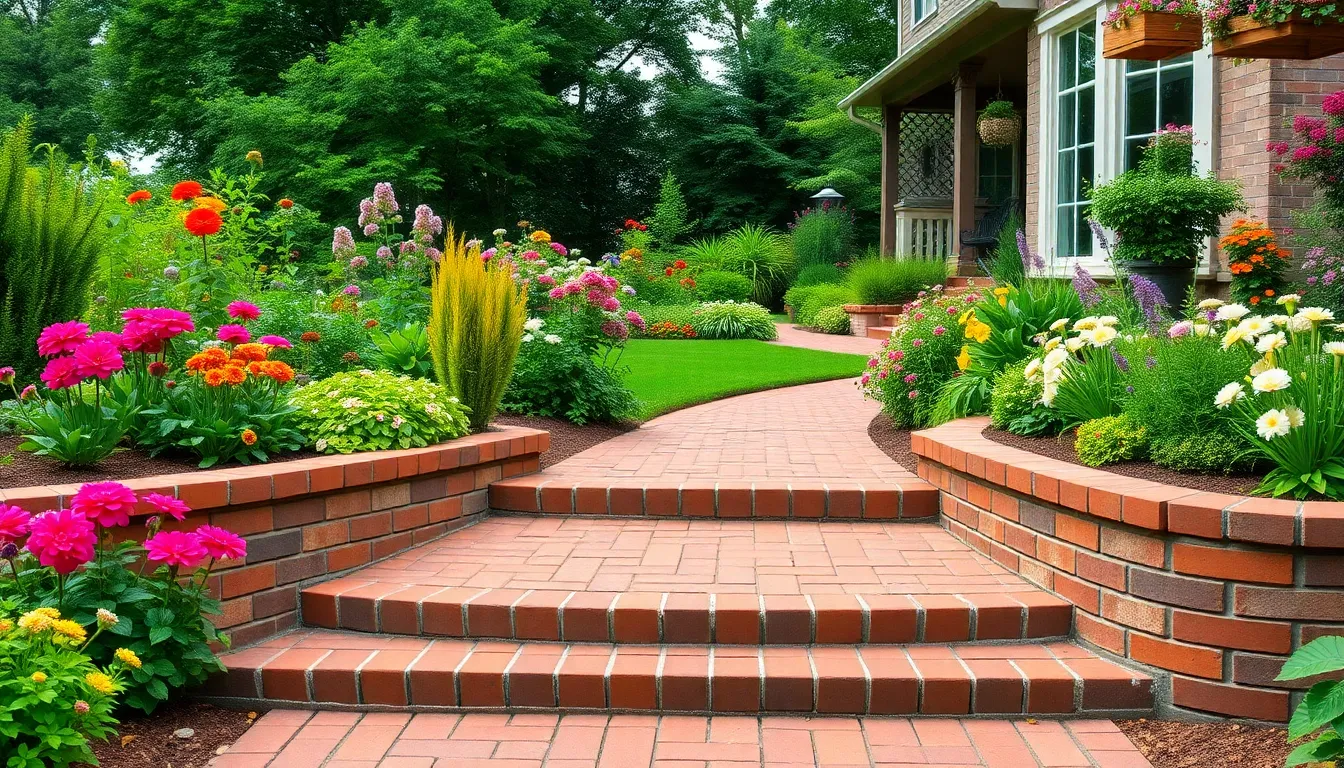
Brick and masonry garden steps bring timeless elegance to outdoor spaces while offering exceptional durability and versatility. We’ve found these materials create stunning pathways that enhance both contemporary and vintage garden designs.
Traditional Red Brick Steps
Traditional red brick steps offer a warm, inviting aesthetic that complements virtually any garden style. We recommend using standard clay bricks arranged in stretcher or herringbone patterns for maximum visual appeal. Sand-set mortar provides the flexibility and drainage these steps need to withstand weather changes. Red brick construction adapts beautifully to formal garden settings as well as cottage-style landscapes. Weather-resistant properties make these steps an excellent long-term investment for your outdoor space.
Concrete Block Foundation
Concrete block foundations beneath brick veneer ensure structural integrity and longevity for your garden steps. We use this combination method to provide the classic appearance of brick while maintaining the strength of masonry construction. Concrete blocks create essential stability, particularly in regions with harsh weather conditions or unstable soil. Foundation systems like these prevent settling and cracking over time. Professional installation ensures your brick steps will maintain their beauty and function for decades.
Mixed Material Combinations
Mixed material combinations allow us to create unique garden features that stand out from traditional single-material designs. Brick treads paired with stone risers offer striking visual contrast while maintaining functionality. Wooden handrails combined with brick facades provide both safety and aesthetic appeal. Metal accents integrated with brick steps create modern touches in classic designs. Custom combinations adapt to exact site conditions and personal design preferences, making each installation truly unique.
Creative DIY Garden Steps Using Recycled Materials
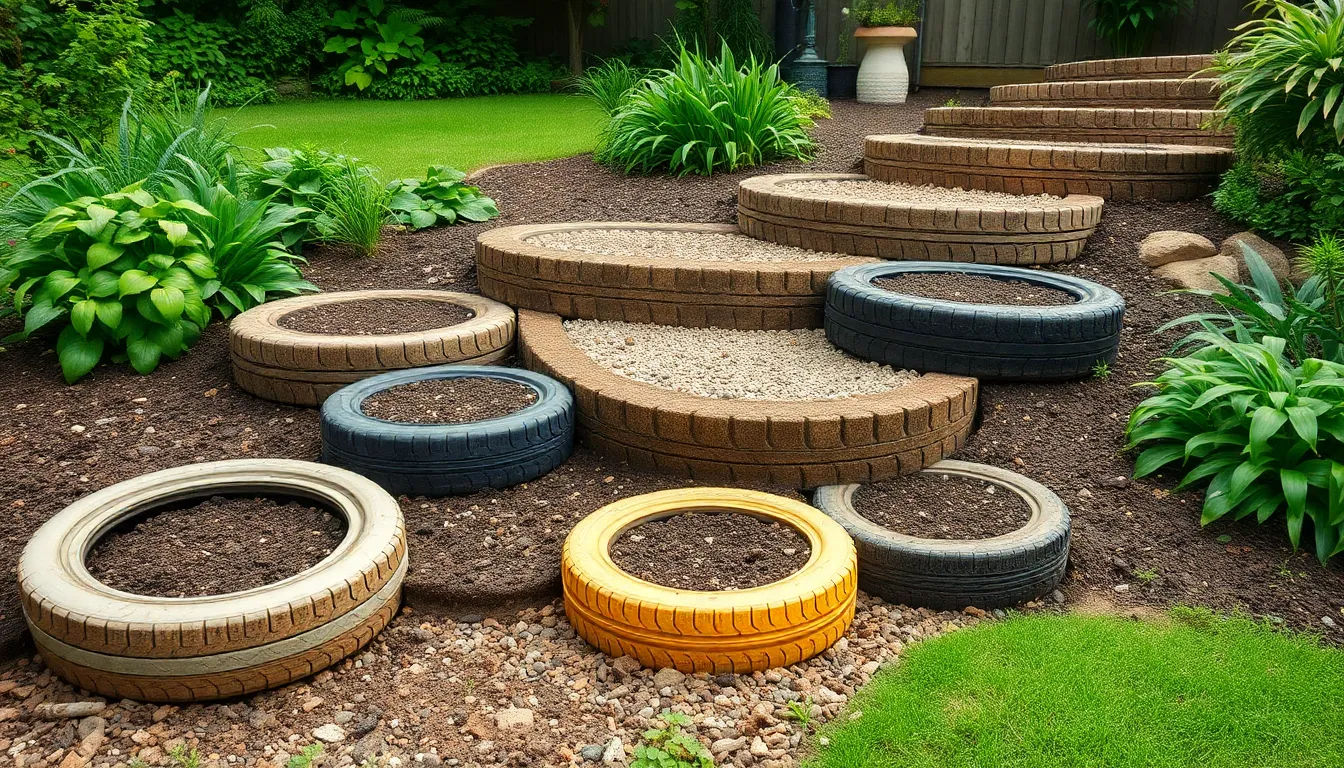
Transforming discarded materials into functional garden steps offers an eco-friendly approach that reduces waste while creating unique outdoor features. We’ll explore several innovative methods that combine sustainability with practical design answers.
Repurposed Tire Steps
Old car tires provide an excellent foundation for building sturdy, slip-resistant outdoor stairs that cost significantly less than traditional materials. We cut tires and lay them flat in a stair pattern, then fill each tire with soil, gravel, or concrete to create stable stepping surfaces. Stakes and guide strings help us maintain proper alignment during installation.
This method proves particularly effective for informal garden areas where building codes allow such installations. We recommend checking local regulations before beginning construction, as tire steps may not meet all municipal requirements. The rubber surface naturally provides excellent traction in wet conditions, making these steps safer than many conventional options.
Concrete Mold Designs
Concrete molds offer exceptional flexibility for creating customized garden steps that can be reused across multiple projects. We pour concrete into pre-made forms or repurpose household items as creative molds to achieve uniform or deliberately varied shapes. This approach allows complete control over step dimensions and surface textures.
The durability of concrete ensures these steps withstand harsh weather conditions while maintaining their appearance for years. We can create matching sets for consistent design or experiment with different mold shapes to add visual interest throughout the garden. The ability to reuse molds makes this method cost-effective for larger projects requiring multiple steps.
Broken Concrete Chunks
Urbanite, or broken concrete pieces from demolition projects, creates rustic garden steps with naturally weathered character that integrates seamlessly into industry settings. We stack these irregular chunks or secure them with mortar to form sturdy, organic-looking staircases that complement natural garden elements. The varied textures and weathered surfaces add authentic charm while providing excellent erosion control on slopes.
This material remains readily available from construction and demolition sites, making it an affordable and sustainable choice for budget-conscious gardeners. We find that broken concrete’s natural aging process eliminates the stark appearance of new materials, creating steps that look established from the moment of installation.
Planted Garden Steps with Integrated Landscaping
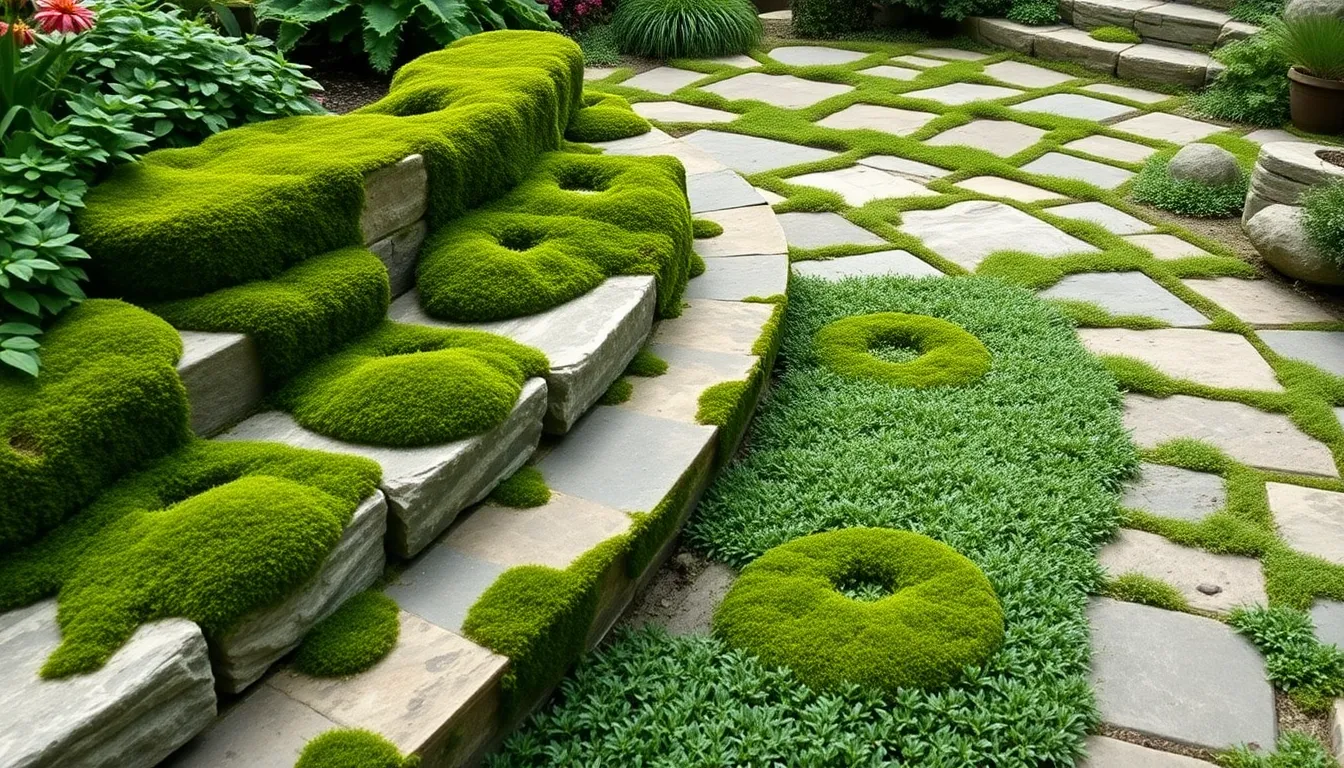
Combining garden steps with living elements creates stunning outdoor spaces that blend functionality with natural beauty. We’ll explore innovative approaches that transform ordinary pathways into vibrant, integrated industry features.
Moss-Covered Stone Steps
Natural moss coverage transforms stone steps into organic garden features that harmonize beautifully with surrounding vegetation. We achieve this weathered aesthetic by encouraging moss growth in shaded, moisture-rich environments where these tiny plants thrive naturally.
Stone steps develop moss coverage over time when positioned in areas receiving indirect sunlight and consistent moisture. Creating optimal conditions involves selecting locations with natural shade from trees, shrubs, or nearby structures that maintain humidity levels throughout the day.
Maintenance requirements remain minimal once moss establishes itself on stone surfaces. We find that established moss colonies need little intervention beyond occasional misting during particularly dry periods, making this approach perfect for low maintenance garden designs.
Herb Garden Step Planters
Functional herb planters built into step structures provide convenient access to fresh cooking ingredients while improving visual appeal. We integrate raised planting areas directly into each step level, creating terraced herb gardens that maximize growing space on sloped terrain.
Strategic herb selection ensures compatibility between different plant varieties sharing the same growing conditions. Mediterranean herbs like rosemary, thyme, and oregano work exceptionally well together, requiring similar light exposure and water requirements while offering complementary textures and fragrances.
Accessibility becomes a key advantage when herbs grow at varying heights along stepped pathways. We position frequently used herbs like basil and parsley on easily reached levels, while placing decorative varieties such as lavender on higher or lower tiers for visual impact.
Ground Cover Integration
Cohesive ground covers create seamless transitions between step surfaces and surrounding garden areas. We plant low growing species like creeping thyme or sedum in gaps between steps, establishing visual continuity that unifies the entire pathway design.
Low maintenance characteristics make ground covers ideal for busy gardeners seeking beautiful results without extensive upkeep. These hardy plants typically establish quickly and spread naturally, filling spaces between stones or concrete while requiring minimal watering once established.
Traffic tolerance varies among ground cover options, with some varieties handling occasional foot traffic better than others. We recommend hardy selections like Irish moss or ajuga for areas receiving moderate use, while reserving delicate species for purely decorative spaces between less frequently used steps.
Modern Concrete Garden Steps for Contemporary Homes
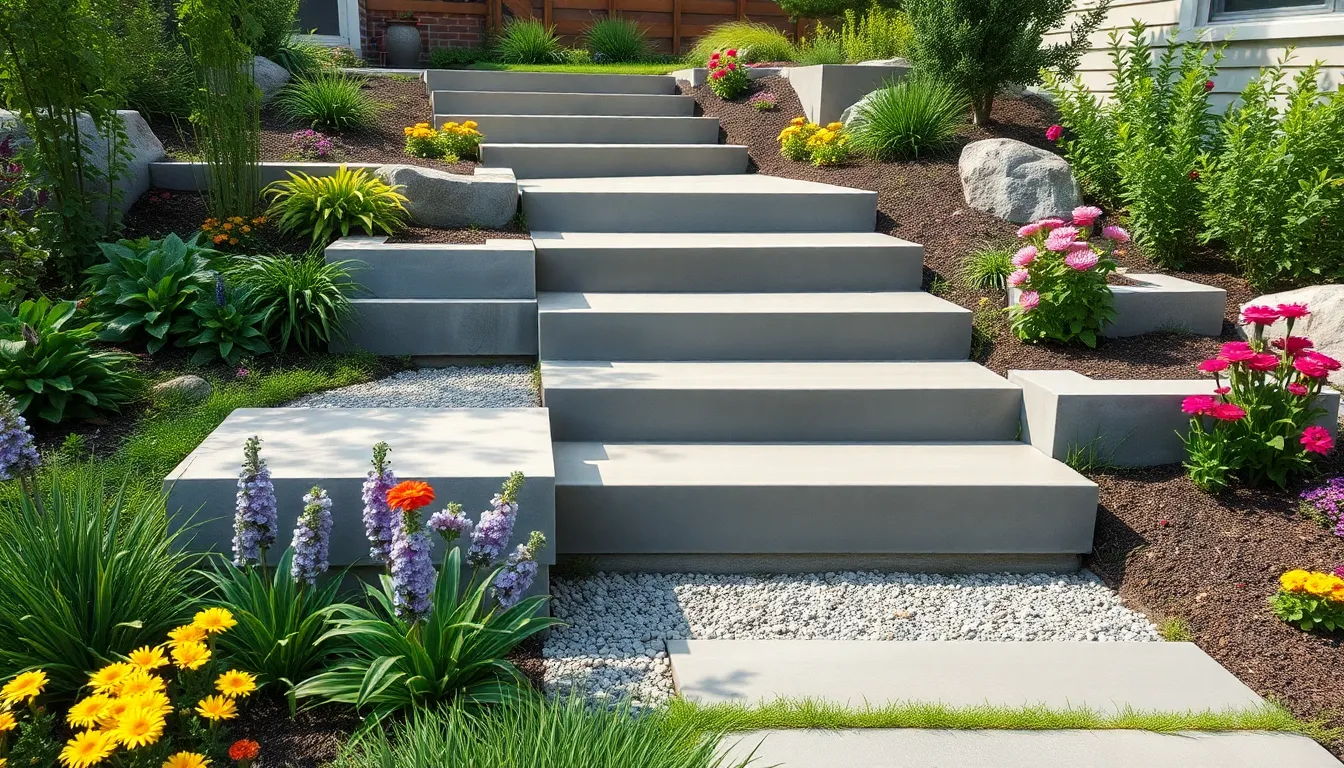
Modern concrete steps bring sleek sophistication to contemporary landscapes while offering incredible durability and design flexibility. We’ll explore three key approaches that can transform your garden into a stunning architectural statement.
Poured Concrete Designs
Poured concrete allows for custom designs and shapes, making it the most versatile option for various landscapes. We can create flowing curves, angular geometries, or integrated planters that perfectly match your home’s contemporary aesthetic. Clean lines and minimalism define this approach, delivering the sleek look that modern homeowners desire.
Durability stands out as poured concrete’s greatest advantage, requiring less maintenance compared to other materials like wood or natural stone. Integration with landscaping becomes seamless when we pour concrete that connects with existing retaining walls or curbs. Architectural interest develops when we experiment with different shapes and sizes, creating steps that serve as sculptural elements in your garden.
Concrete Pavers Layout
Flexibility in design layout makes concrete pavers an excellent choice for homeowners who want pattern variety and visual impact. We can arrange pavers in herringbone, running bond, or custom geometric patterns that complement your contemporary home’s architecture. Easy repair becomes possible since individual pavers can be replaced if damaged, making long term maintenance more manageable.
Aesthetic variety emerges when we combine different paver colors and textures to create visually appealing designs. Various patterns and configurations allow us to match your exact style preferences while maintaining the clean, modern look you’re seeking. Installation typically requires less specialized equipment than poured concrete, making this option more accessible for many homeowners.
Decorative Aggregate Finishes
Aesthetic enhancement comes naturally with decorative aggregate finishes that add color and texture to concrete surfaces. We can incorporate colored concrete, imprinted patterns, or textures that enhance the overall design while maintaining contemporary appeal. Combination materials work beautifully when we mix concrete with wood or natural stone accents.
Durability improvements result from these finishes, which provide additional strength and resistance to wear over time. Visual interest increases significantly when we select aggregates that complement your home’s color palette and architectural features. These finishes can range from exposed pebbles to crushed glass, each offering unique reflective properties that change throughout the day.
Gravel and Decomposed Granite Pathway Steps
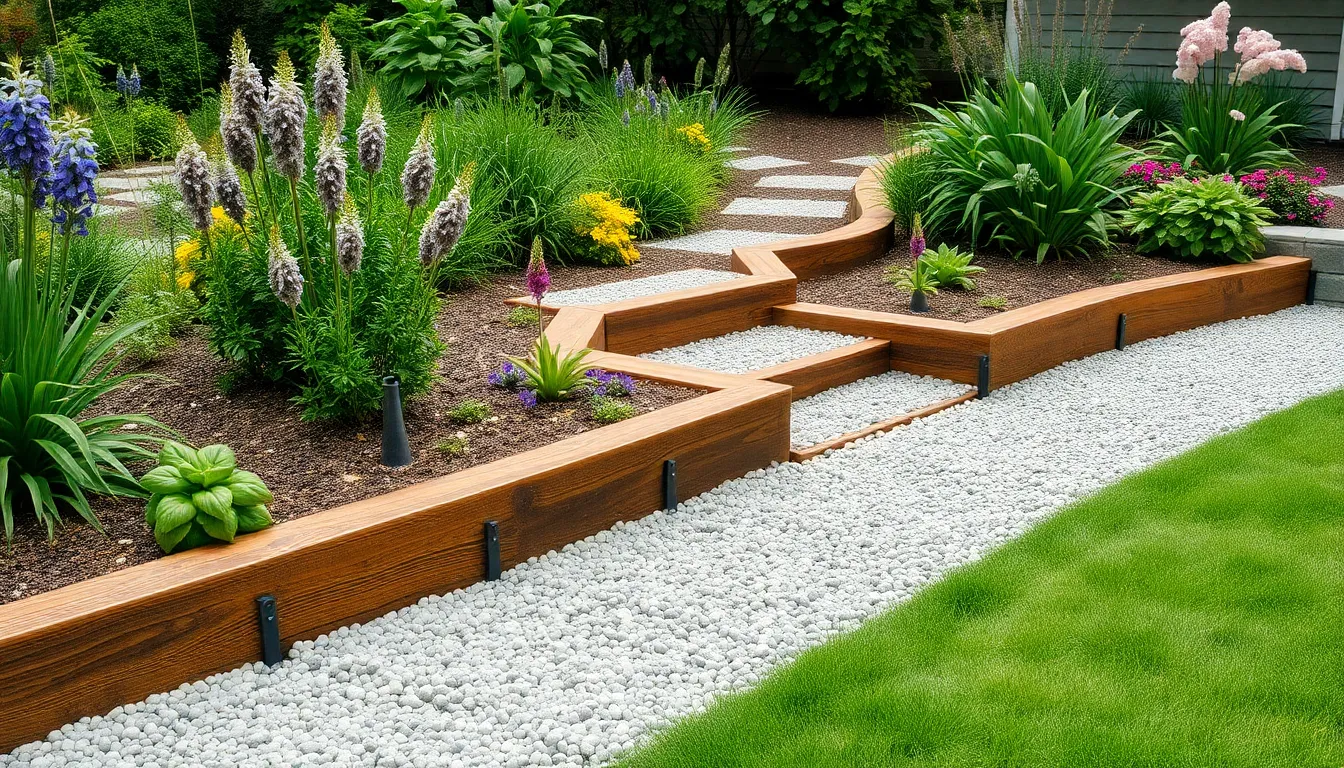
Gravel and decomposed granite create stunning natural pathways that offer both beauty and functionality for sloped gardens. These materials provide excellent drainage while maintaining a sophisticated appearance that complements various industry styles.
Timber Edge Containment
Timber edges bring rustic charm to garden steps while serving essential structural purposes. We recommend using pressure-treated lumber or naturally rot-resistant woods like cedar to create clean boundaries that prevent material migration.
Wooden containment systems require minimal installation effort compared to masonry alternatives. These edges help maintain the step structure by keeping gravel and decomposed granite properly positioned during weather changes and foot traffic. Installation involves securing boards with industry spikes or rebar driven through pre-drilled holes into the ground.
Different timber widths create varying visual impacts throughout your garden pathway design. Natural wood weathering adds character over time, developing a silver-gray patina that blends seamlessly with outdoor environments. Maintenance includes periodic inspection for loose boards and occasional re-securing of fasteners.
Metal Step Edging
Metal edging delivers contemporary sophistication while providing superior durability for garden step installations. Steel and aluminum options resist weather damage better than organic materials, maintaining clean lines year after year.
Industrial-grade edging materials create precise boundaries that enhance the professional appearance of decomposed granite pathways. We suggest using cor-ten steel for its attractive rust patina or powder-coated aluminum for color-matched installations. These materials flex slightly with ground movement, reducing cracking and separation issues.
Installation requires cutting materials to exact lengths and securing them with stakes driven below ground level. Professional-looking results come from proper alignment and consistent height maintenance across each step section. Metal edging costs more initially but provides long-term value through reduced replacement needs.
Permeable Surface Benefits
Permeable surfaces transform problematic drainage areas into functional garden features that prevent water accumulation. These materials allow rainfall to infiltrate naturally instead of creating runoff that damages surrounding plants and structures.
| Benefit | Impact |
|---|---|
| Drainage improvement | Reduces puddles by 90% compared to solid surfaces |
| Erosion prevention | Minimizes soil loss during heavy rainfall events |
| Maintenance reduction | Requires 50% less cleaning than impermeable alternatives |
Environmental advantages include groundwater recharge and reduced strain on storm water systems. We’ve observed that permeable pathways require less frequent repairs because water doesn’t freeze and expand within the material structure.
Natural filtration occurs as water passes through gravel layers, removing pollutants before reaching soil and groundwater supplies. This sustainable approach supports healthy garden ecosystems while providing attractive walkways that handle various weather conditions effectively.
Steep Slope Garden Steps for Challenging Terrain
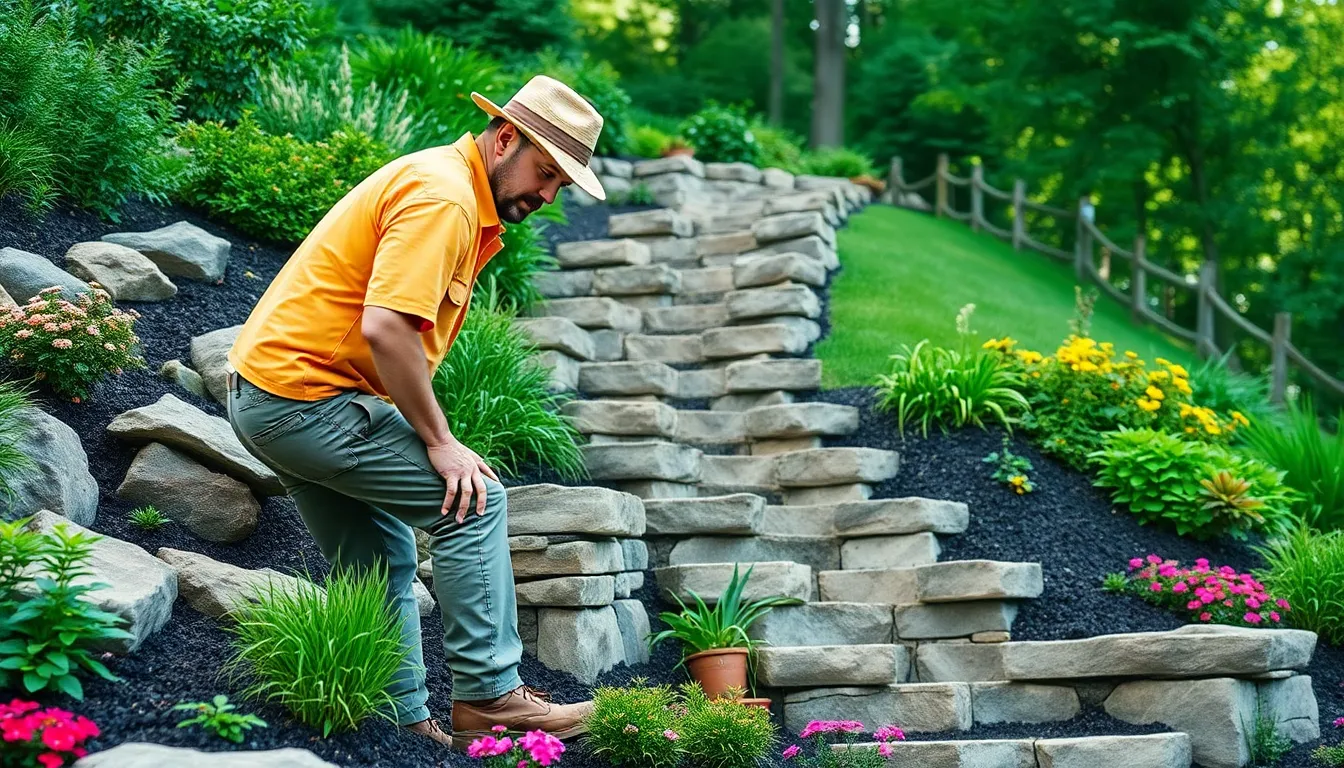
Steep slopes present unique challenges that require specialized design approaches to create safe and functional garden pathways. We’ll explore proven techniques that transform challenging terrain into accessible and beautiful outdoor spaces.
Switchback Step Design
Switchback steps create a zigzag pattern that dramatically reduces the steepness of challenging slopes while improving usability. Building multiple shorter steps instead of fewer steep ones makes the incline more manageable for daily navigation. This design approach helps reduce strain on knees and joints, making garden access comfortable for people of all ages.
Key Benefits of Switchback Design:
| Benefit | Description |
|---|---|
| Reduced Steepness | Multiple shorter steps vs. fewer steep ones |
| Enhanced Safety | Zigzag pattern provides better foot placement |
| Less Physical Strain | Easier navigation reduces knee stress |
| Improved Accessibility | Suitable for various mobility levels |
Planning your switchback layout requires careful consideration of the total slope distance and desired step height. We recommend keeping individual step rises between 6 to 8 inches for optimal comfort and safety. Strategic placement of landing areas at direction changes provides rest spots and enhances the overall user experience.
Retaining Wall Integration
Retaining walls provide essential structural support that keeps soil in place while creating stable foundations for your garden steps. These walls prevent erosion and soil movement that could compromise step stability over time. Proper integration of retaining structures with your step design enhances both functionality and visual appeal throughout your garden.
Retaining Wall Materials and Benefits:
- Natural Stone Walls: Offer rustic charm and blend seamlessly with industry features
- Concrete Block Systems: Provide modern aesthetics with excellent structural integrity
- Timber Retaining Walls: Create warm, natural appearances that complement wooden steps
- Brick Construction: Delivers traditional appeal with long lasting durability
Building retaining walls requires proper drainage considerations to prevent water buildup behind the structure. We suggest installing drainage pipes and gravel backfill to direct water away from the wall foundation. Height restrictions may apply in your area, so check local building codes before beginning construction.
Erosion Control Methods
Erosion control becomes critical when constructing garden steps on steep slopes where water runoff can quickly damage your investment. Geotextiles placed under step foundations help stabilize soil and prevent erosion by creating a barrier between different soil layers. These materials allow water to pass through while maintaining soil stability around your step structures.
Effective Erosion Control Strategies:
- Geotextile Installation: Stabilizes soil under steps and prevents shifting
- Ground Cover Planting: Establishes root systems that bind soil particles together
- Drainage Channels: Direct water flow away from step foundations
- Mulching Techniques: Protect exposed soil surfaces from water impact
Planting ground cover around your steps creates natural erosion barriers while adding visual interest to the industry. We recommend selecting hardy plants like creeping thyme, sedum varieties, or native grasses that thrive in your climate conditions. These plants develop extensive root systems that bind soil particles and reduce erosion risks significantly.
Installing proper drainage systems prevents water from pooling around step foundations and causing structural damage. French drains, surface channels, and permeable materials work together to manage water flow effectively. Regular maintenance of these erosion control measures ensures long term stability and appearance of your steep slope garden steps.
Budget-Friendly Garden Steps for Cost-Conscious Projects
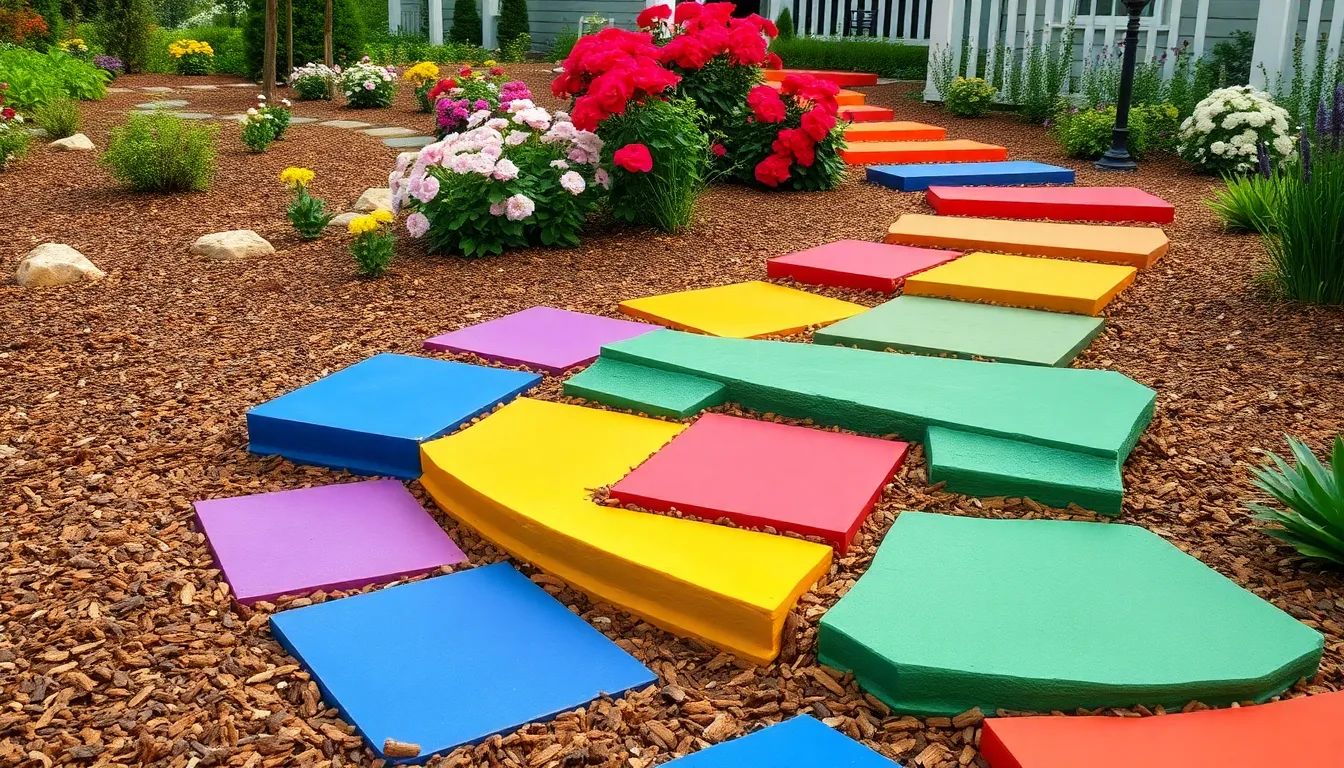
Creating beautiful garden steps doesn’t require very costly. We’ll explore three highly effective approaches that deliver impressive results while keeping costs minimal.
Mulch and Wood Chip Steps
Mulch pathways offer one of the most affordable answers for gentle garden slopes. Wood chips provide natural texture that blends seamlessly with existing landscaping while requiring minimal installation expertise. We recommend embedding flagstone or stepping stones directly into the mulch to create defined treads that reduce wear patterns over time.
Installation becomes straightforward when you create bordered sections using industry edging or timber frames. Fill each section with 2-3 inches of quality mulch or wood chips for optimal stability. Natural decomposition means you’ll need to replenish materials annually, but this actually improves soil quality underneath.
Light foot traffic works best with this approach since heavy use can displace materials quickly. Choose hardwood chips over softwood varieties for longer lasting coverage that resists breakdown from weather exposure.
Painted Concrete Options
Concrete slabs transform into vibrant garden features when enhanced with paint or stains. Basic concrete blocks cost significantly less than natural stone while providing exceptional durability for high traffic areas. Paint application opens unlimited color possibilities that can complement your existing garden palette or create bold accent statements.
Surface preparation ensures paint adhesion that withstands weather extremes and foot traffic. Clean concrete thoroughly and apply primer designed for masonry surfaces before adding your chosen topcoat. Concrete stains penetrate deeper than paint and offer subtle color variations that mimic natural stone appearances.
DIY installation tutorials make this project accessible for most homeowners with basic construction skills. Standard concrete pavers can be arranged in various patterns and painted individually for custom designs that reflect personal style preferences.
Salvaged Material Ideas
Reclaimed materials create unique garden steps while reducing project costs to nearly zero. Old railroad ties, salvaged bricks, and discarded stone slabs offer character that new materials simply can’t match. Sleepers positioned as risers and secured to treated timber posts form incredibly stable step structures that age beautifully over time.
Natural stone slabs salvaged from construction sites or demolition projects provide rustic appeal while helping control erosion on steep slopes. Inspect salvaged materials carefully for structural soundness and treat wooden elements with appropriate preservatives to extend lifespan.
Combining old timbers with pea gravel and minimal concrete creates stable foundations that support years of regular use. This approach reduces landfill waste while adding distinctive personality to your garden steps that reflects environmental consciousness and creative problem solving.
| Material | Cost Range | Durability | Maintenance Needs |
|---|---|---|---|
| Mulch/Wood Chips | Very Low | 1-2 years | Annual replenishing |
| Painted Concrete | Low | 10+ years | Periodic repainting |
| Salvaged Materials | Minimal | 5-15 years | Varies by material |
| Railroad Sleepers | Low | 15+ years | Initial treatment required |
Safety Considerations for Garden Step Installation
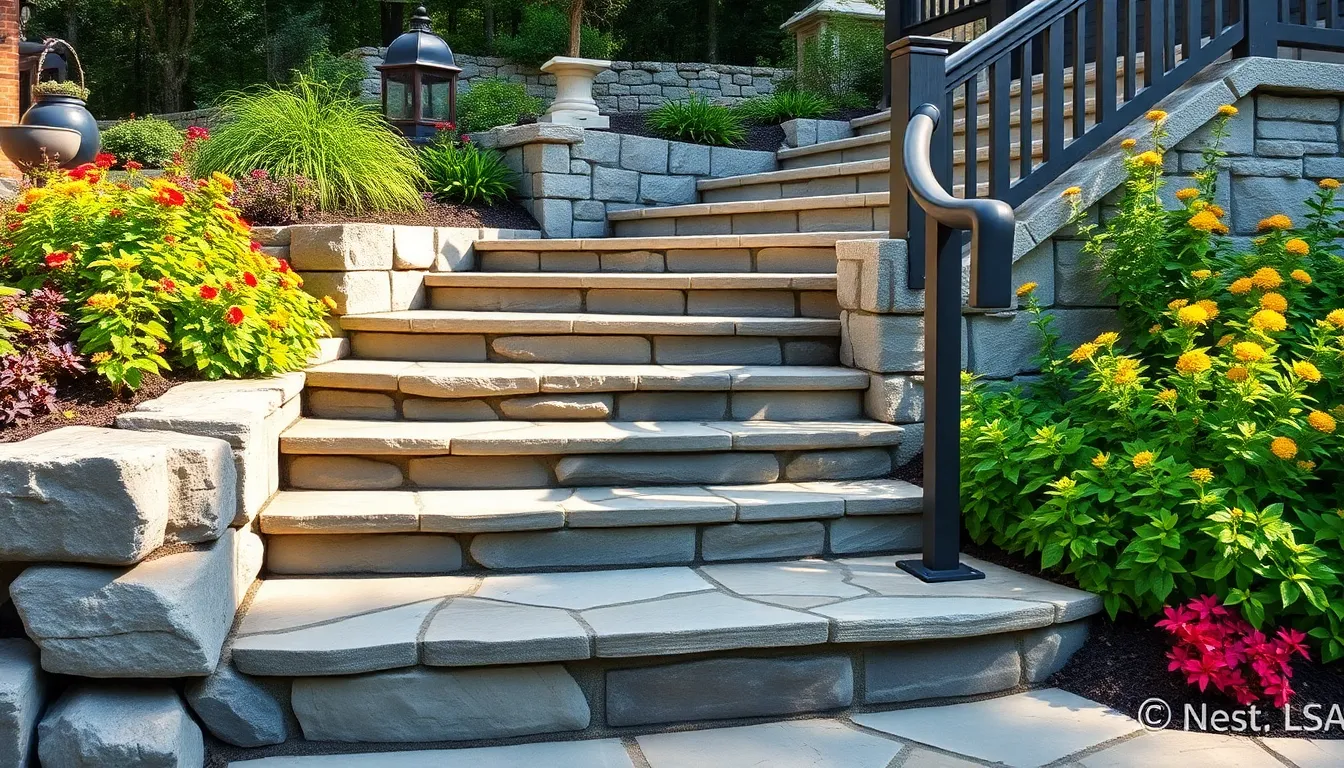
We believe that garden step safety forms the foundation of every successful outdoor stairway project. Our attention to proper installation prevents accidents while ensuring your steps remain stable and secure for years to come.
Proper Step Height Ratios
Step riser heights must remain consistent throughout your garden stairway to minimize trip hazards and provide comfortable walking rhythm. We recommend keeping garden step risers between 4 inches (100 mm) minimum and 8 inches (200 mm) maximum, with most garden applications working best at 6 inches (150 mm) or below.
| Riser Height | Recommended Tread Depth |
|---|---|
| 4 inches (100 mm) | 20 inches (500 mm) |
| 6 inches (150 mm) | 12-16 inches (300-400 mm) |
| 8 inches (200 mm) | 10 inches (250 mm) |
Lower riser heights pair with deeper treads to create gentle ascents perfect for garden settings. Higher risers require shallower treads to maintain proper proportions. Each step should maintain uniform height, width, and depth throughout straight stairway sections.
Non-Slip Surface Treatments
Surface treatments dramatically improve safety by providing enhanced grip during wet weather conditions. We recommend textured materials or specialized non-slip coatings applied directly to step treads for maximum effectiveness.
Contrasting colors help users identify step edges clearly against surrounding garden areas. Materials should stand out visually from nearby plantings and hardscaping elements. Weather resistance becomes crucial since outdoor steps face constant exposure to rain, snow, and temperature changes.
Natural stone surfaces often provide inherent texture for slip resistance. Concrete steps benefit from brushed finishes or aggregate additions during installation. Wooden steps require regular maintenance with slip resistant stains or specialized grip strips.
Handrail Installation Guidelines
Handrails provide essential support for elderly users and those with mobility challenges handling garden steps. We install handrails with diameters between 1.25 and 2 inches for optimal grip comfort across different hand sizes.
Round or oval handrail profiles work best for most applications. Grooved surfaces add extra slip resistance during wet conditions. Integrated lighting along handrail systems or step edges improves visibility during evening hours.
Balustrades offer additional stability beyond basic handrails for challenging installations. Anchoring systems must resist both lateral and vertical forces without relying on simple nails or toenails susceptible to withdrawal. Self supporting designs work well when direct structural attachment isn’t possible.
Conclusion
Creating beautiful garden steps doesn’t require a massive budget or professional expertise. We’ve shown you how to transform sloped terrain into stunning pathways using everything from natural stone and reclaimed wood to creative recycled materials and modern concrete designs.
The key lies in choosing materials that complement your garden’s existing style while prioritizing safety and functionality. Whether you opt for rustic fieldstone steps moss-covered elegance or sleek contemporary concrete we’ve provided options for every taste and budget.
Remember that proper planning and attention to safety details like consistent step heights and non-slip surfaces will ensure your garden steps remain both beautiful and functional for years to come. Your sloped yard can become the highlight of your outdoor space with the right approach and materials.
Frequently Asked Questions
What materials work best for building garden steps?
Natural stone, wood, brick, and concrete are the most popular materials for garden steps. Natural stone like flagstone and granite offers durability and timeless elegance. Cedar wood provides warmth and weather resistance. Brick delivers classic appeal with excellent longevity. Concrete allows for modern, customizable designs. Choose based on your garden’s style, budget, and maintenance preferences.
Can I build garden steps on a steep slope?
Yes, steep slopes can accommodate garden steps using specialized designs like switchback patterns. This zigzag approach reduces steepness and improves safety. Consider adding retaining walls for structural support and proper drainage. Professional consultation may be helpful for extremely steep terrain to ensure stability and prevent erosion.
How much do DIY garden steps typically cost?
DIY garden step costs vary widely depending on materials. Budget-friendly options like mulch or painted concrete can cost under $100. Mid-range materials like cedar planks or basic stone run $200-500. Premium materials like granite or elaborate designs can exceed $1,000. Recycled materials offer the most economical solutions.
What’s the ideal height for garden step risers?
Garden step risers should be between 4 to 8 inches high, with 6 inches being optimal for comfort and safety. Maintain consistent heights throughout your stairway to prevent tripping hazards. Taller risers make climbing more difficult, while shorter ones may feel awkward. Always prioritize user safety and accessibility.
How do I make garden steps slip-resistant?
Add non-slip treatments like textured surfaces, anti-slip strips, or rough finishes to improve traction. Choose materials with natural grip like rough stone or textured concrete. Apply non-slip coatings to smooth surfaces. Ensure proper drainage to prevent water accumulation, and consider contrasting colors to improve step visibility.
Can I integrate plants into my garden steps?
Absolutely! Planted garden steps create beautiful, living pathways. Consider moss-covered stone steps for shaded areas, herb garden planters between levels, or ground covers that tolerate light foot traffic. Ensure proper drainage and choose hardy plants that won’t obstruct the walking path or require excessive maintenance.
Do garden steps require professional installation?
Many garden step projects are suitable for DIY enthusiasts with basic construction skills. Simple designs using pavers, wood, or basic stone can be self-installed. However, complex projects involving steep slopes, extensive excavation, or structural retaining walls may benefit from professional consultation to ensure safety and longevity.
How do I maintain different types of garden steps?
Maintenance varies by material. Stone steps need occasional cleaning and joint resealing. Wooden steps require annual staining or sealing and inspection for rot. Brick steps need joint maintenance and occasional cleaning. Concrete steps are low-maintenance but may need crack repairs. Regular debris removal and drainage checks benefit all materials.

